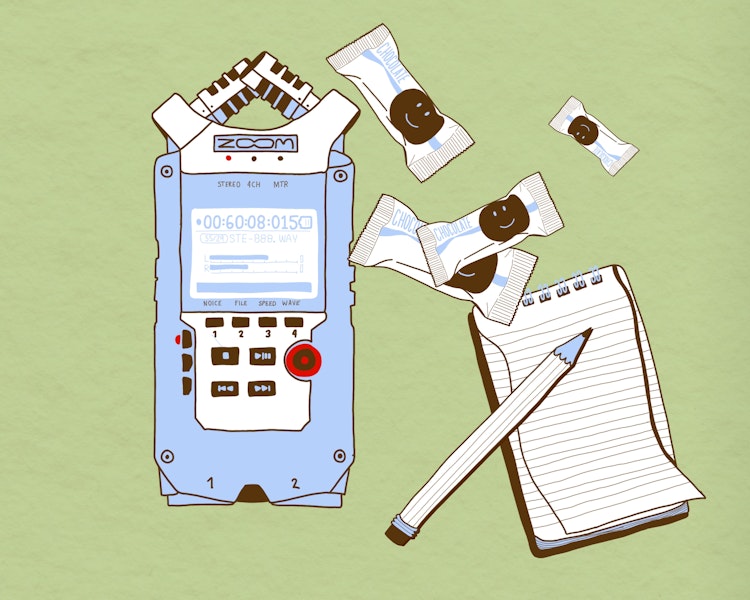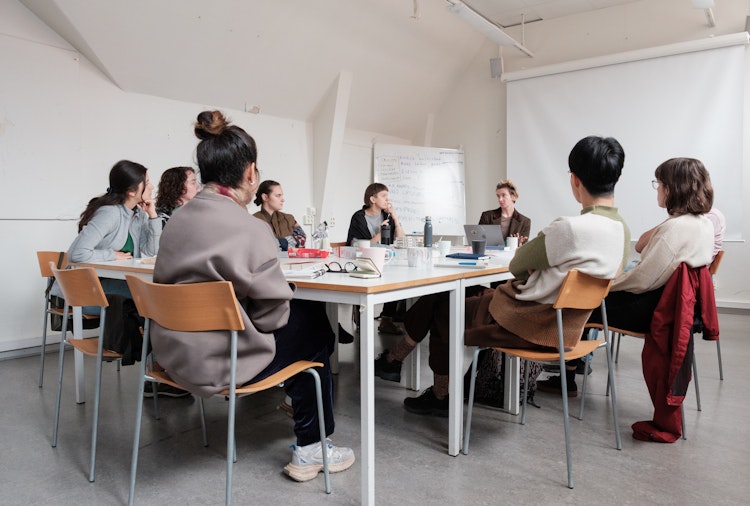

Åsa Dybwad Norman and Ben Lignel
Fanny Schwarz
Sebastian Kok, Vihar Kotecha and Abrakadabra
The ninth issue of The Vessel, Make Me See, wants to celebrate and reflect upon the art of noticing, and describing, craft in action. What do we see when watching people make? Editors Åsa Dybwad Norman and Ben Lignel introduce the workshop series that sparked this issue of The Vessel, including their collaboration with student editors Sofie Alm Nordsveen, Carla Rotenberg, and Iliana Papadimitriou, and contributors from three leading Nordic art academies: the Oslo National Academy of the Arts in Norway, HDK-Valand University of Gothenburg in Sweden and Aalto University in Finland.
The ninth issue of The Vessel, Make Me See, wants to celebrate and reflect upon the art of noticing, and describing, craft in action. What do we see when watching people make? What words can do justice to haptic and tacit knowledge and skills deployed by schooled and self-taught makers, at home, in the street, or in dedicated making environments?
These questions spring from our commitment to develop a language for craft. As craft practitioners, commentators, and educators, we are interested in finding words that do justice to the sensorial aspect of making, and living with, crafted objects, and in developing with students what could be described as a “literacy of the handmade”.
The project began at HDK-Valand, University of Gothenburg, in Sweden, where we both teach. Our students have over the last few years produced excellent observation assignments, which contradict their own ambivalent feelings towards writing, and allow them to position themselves in relation to craft at large: which craft they decide to pay attention to — this assignment has shown time and again — is a political decision.

We were curious: what would the same assignment produce over a wider territory? Would students and alumni in sister institutions abroad welcome an opportunity to write about practices other than their own? Would they be interested in looking around them at “people making stuff”, and in examining the conditions in which skilled gestures take place?
These questions were discussed with 27 master's students and alumni from HDK-Valand in Sweden, Oslo National Academy of the Arts in Norway, and Aalto University in Finland, in the autumn of 2024. These work sessions were not part of coursework, but took place on the grounds of the three partnering universities, in a transnational effort to develop a toolbox for looking, writing, and talking about, making. We worked together for two days, and shared conceptual tools (borrowed mostly from ethnography) with the students that would help them conduct an observational assignment in a situation of their choice, and later write a description of that situation.

For this issue of The Vessel, a team of editors selected 12 out of the 24 texts that came out of this process (all the texts will be published by Art Monitor in a printed publication later in the spring of 2025). The texts are all edited by the two of us, and three assistant editors: Carla Rotenberg Taboada (Aalto University), Iliana Papadimitriou (Oslo National Academy of the Arts), and Sofie Alm Nordsveen (HDK-Valand). When working on the selection for The Vessel,1 we focused on the texts’ subject matter, their writerly and observational qualities. We then started to consider the texts in relation to one another, and grouped them according to the types of situations they described (environment, social set-up). We agreed that this categorisation helped us see the most richness in craft, and finally proceeded to pick 12 texts that showcased as diverse a set of making conditions as possible. In other words, the selections we decided to include in The Vessel are not necessarily the better written texts, but the texts that together showcase the breadth of craft’s occurrence in the Nordics.
Having embraced our invitation to reflect critically on what they consider worth observing, the contributors’ essays provide a map of the rich diversity of what “making” looks like in Norway, Sweden, Finland (and Austria), and do reflect on the many conditions in which people choose to “make”: at home and in the street, alone or in groups, in sheltered or challenging environments, close to or very, very far away from their birthplace. Though we assumed that “mapping craft” would allow us to distinguish between craft-less and craft-full environments, the collected essays instead reveal skilled gestures to happen everywhere, almost all the time: craft — understood as the intentional transformation of matter at a human scale2 — is ubiquitous.
The student contributors’ biggest challenge was to refrain from analysing the situations they observed. This was hard work: having gone into their chosen situation with a critical mindset, they understood that the situations they described were imbricated into systems of extraction, consumption, transmission, and maintenance, often central to their chosen subject’s daily concerns. “Making things” connects people to multiple ecosystems at different scales, and to the (in)actions and policies that shape them.
In order to provide a theoretical framework to their descriptive texts, we invited two writers and makers who were not a part of the pedagogical structure of this project: Swedish curator, maker, and writer Evelina Hedin and American artist, editor, and scholar Sara Clugage. We asked them to reflect critically upon the subject of observation from two different angles. Evelina’s text, ‘What We Don’t See When Watching People Make’, challenges the hegemony of the visual, and is asking us to rethink how languages operate, not as a tool of distance or organisation, but as an extension of our hands and senses. Meanwhile Sara’s contribution, ‘Paying Attention’, leans on Marxist labour theory and more recent scholarship on the process genre to reflect on the reciprocal exchange between someone making and someone watching them make: paying attention, she suggests, is one of the ways we bring visibility, and ultimately value, to skilled gestures.

The collection of 14 texts has been sequenced by thematic clusters, with a view to leading the reader through a coherent — but invented — narrative arc. The first three texts showcase making environments that are preliminary to future developments: nail salon, basement workshop, and 3D printing shop. They are followed by Sara Clugage’s reflection on craft, labour, and value. The second cluster of three observations was grouped for contrast. The observations present three radically different conditions for making craft, which in turn impact our understanding of where and what craft is: in the home, the professional workshop, or the community centre. The third triad zooms out, and puts craft in relation to wider ecological phenomena: cultivation, animal life, and climate change. Finally, the last three observations, introduced by Evelina Hedin’s thoughts on the hegemony of the visual, meet craft at the fragile moment of its transmission between biological or chosen kin. They end, fittingly we thought, with a group of elderly and highly experienced makers returning to school.
Each of the essays in this publication is accompanied by an illustration by textile and tattoo artist Fanny Schwarz. We approached this HDK-Valand alumna because her repertory of two- and three-dimensional forms populates the outskirts of craft, and is informed by her deep understanding of making processes. The self-contained and serial format of tattoos, and Fanny’s prior work around making gestures, resonates with some of the systematic collection of craft objects we have been looking at:3 we are very happy that she accepted to lend her creativity to this project!
The texts gathered in this issue ultimately pay tribute to craft students’ fine-tuned understanding of materials and making gestures, and to the precision of their observation. They demonstrate a knowledge that they already have, but seldom articulate, about the way objects come into being, and the ecologies that make their existence possible.
We are very grateful to the Norwegian Crafts task force for trusting this project from its inception, and giving a platform to students and graduates from learning institutions in Norway, Sweden, and Finland. Like them, we believe that the writers in this publication are the craft commentators of the future.
This project was made possible through: Norwegian Crafts, the Nordic Culture Fund, Nordic Culture Point, Göteborgs Slöjdförening, and Estrid Ericssons Stiftelse. Participating colleagues and schools: Professor Franz Petter Schmidt and Professor Susanne Winterling, Oslo National Academy of the Arts. Professor Julia Lohmann, Aalto University. Katarina Andersson, Senior Lecturer of Craft and Head of the Craft & Fine Art Unit, HDK-Valand, University of Gothenburg. Special thanks to Klara Albertsson, Ann-Maj Risgaard Nielsen, and Judith Leemann for their early support of the project, and to the many students who over the years have helped us refine our observational workshop. Our ongoing gratitude to Nina Wang and Olav Dalgard for hosting our post-work-session dinners in their home in Oslo.
Special thanks to the many people who agreed to be observed for the purpose of this project:
Annie Johansson, Ajaz Ul Haq, Anna Vikström, Else Cecilie Hødnebø, Ebner Stefan, Federico Fiermonte, George Schiechl, Helene Skuterud, Iliana Papadimitriou, Jan Fagernes, Line Blom Salvesen, Margit Nordsveen, Nina Standerholen, Ole Morten Rokvam, Petri Alroth, the pigeons, Quin Scholten, Sean Fuglseth, the spider, Stig Wilhelm Hødnebø, Tanja Kukkola, Torbjørn Kvasbø, Tessa Lulu Kaner, Tien An Trinh, Trine Midtsund, Trond Inge Heggem, Toril Slåtto Christie, and Vidar Hammer.
Further reading
From the very beginning of this project – and even before that “beginning”, as we were getting ready for it without quite knowing it yet – we invited a number of knowledge holders to be in the room with us and to help us think through questions raised by the tasks at hand. This figurative “invitation” took the form of passing references made in class, and more insistent versions of that: shared lists of resources with hyperlinks, PDFs circulation, informal discussions, formal classroom presentations of scholars and their work. This is the joyful work of lateral knowledge sharing, which is one of the core aspects of Make Me See. We wanted to model some of that sharing here, and reproduce below a very partial list of the writings that accompanied us over the last six months, organised thematically.
A special acknowledgement needs to be made to the MA in Critical Craft Studies, the short-lived but transformational programme directed and largely masterminded by Namita Gupta Wiggers at Warren Wilson College. A number of the references below, and the critical spirit that imbues them, emanate from students and faculty of the programme. For a look at their work, check out the programme’s last publication: https://www.themacrpapers.com
On the practice of everyday life:
On the politics of observing people at work, and considering which work has historically been considered as worth looking at:
On “interconnectedness”, whether it refers to commodity chains, systems thinking, or the ongoingness of objects:
On (non)scalability, or the notion that different stories happen at different scales:
On the art and politics of noticing:
On the reading of objects: